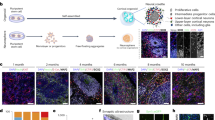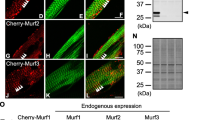Summary
The differentiation grade of cells in culture is dependent on the composition of the culture medium. Two commonly used myogenic cell lines, mouse C2C12 and rat L6, usually differentiate at a low concentration of horse serum. In this study we compared the effect of horse serum with a medium containing a low percentage of Ultroser G and rat brain extract. The maturation grade was evaluated on the basis of various biochemical, (immuno)histochemical and cell-physiological parameters. Substitution of horse serum by Ultroser G and rat brain extract during the differentiation phase resulted in a higher maturation grade of the myotubes of both cell lines, on the basis of creatine kinase activity and the diameter of the myotubes. In addition, the C2C12 myotubes display cross-striation, contain a higher percentage of creatine kinase muscle-specific isoenzyme MM, show a ninefold increase in acetylcholine receptor (AChR) clusters, form a continuous basement membrane, and have a lower resting cytosolic Ca2+ concentration. L6 myotubes show a fivefold increase in AChR clusters and a twofold increase in the expression of the mRNA of the ɛ-subunit of AChR. C2C12 cells show spontaneous contraction and response of cytosolic Ca2+ to various stimulants in contrast to L6 cells which do not. These studies established that the Ultroser G/brain extract medium leads to a higher differentiation grade of both cell lines, but parameters appropriate for use as differentiation markers appear to differ between both cell lines.
Similar content being viewed by others
References
Airey, J. A.; Baring, M. D.; Sutko, J. L. Ryanodine receptor protein is expressed during differentiation in the muscle cell lines BC3H1 and C2C12. Dev. Biol. 148:365–374; 1991.
Askanas, V.; Kwan, H.; Alvarez, R. B.; Engel, W. K.; Kobayashi, T.; Martinuzzi, A.; Hawkins, E. F. De novo neuromuscular junction formation on human muscle fibres cultured in monolayer and innervated by foetal rat spinal cord: ultrastructural and ultrastructural-cytochemical studies. J. Neurocytol. 16:523–537; 1987.
Bakker, A. J.; Head, S. I.; Stephenson, D. G. Time course of calcium transients derived from Fura-2 fluorescence measurements in single fast twitch fibres of adult mice and rat myotubes developing in primary culture. Cell Calcium 21:359–364; 1997.
Baldwin, K. M.; Winder, W. W. Adaptive responses in different types of muscle fibers to endurance exercise. Ann. NY Acad. Sci. 301:411–423; 1977.
Baroffio, A.; Bochaton-Piallat, M.-L.; Gabbiani, G.; Bader, C. R. Heterogeneity in the progeny of single human muscle satellite cells. Differentiation 59:259–268; 1996.
Benders, A. A. G. M.; van Kuppevelt, T. H. M. S. M.; Oosterhof, A.; Veerkamp, J. H. The biochemical and structural maturation of human skeletal muscle cells in culture: the effect of the serum substitute Ultroser G. Exp. Cell Res. 195:284–294; 1991.
Benders, A. A. G. M.; Oosterhof, A.; Wevers, R. A.; Veerkamp, J. H. Excitation-contraction coupling of cultured human skeletal muscle cells and the relation between basal cytosolic Ca2+ and excitability. Cell Calcium 21:81–91; 1997a.
Benders, A. A. G. M.; Groenen, P. J. A.; Oerlemans, F. T. J. J.; Veerkamp, J. H.; Wieringa, B. Myotonic dystrophy protein kinase is involved in the modulation of the Ca2+ homeostasis in skeletal muscle cells. J. Clin. Invest. 100:1440–1447; 1997b.
Brandan, E.; Carey, D. J.; Larrain, J.; Melo, F.; Campos, A. Synthesis and processing of glypican during differentiation of skeletal muscle cells. Eur. J. Cell Biol. 71:170–176; 1996.
Buonanno, A.; Mudd, J.; Merlie, J. P. Isolation and characterization of the β and ε subunit genes of mouse muscle acetylcholine receptor. J. Biol. Chem. 264:7611–7616; 1989.
Cognard, C.; Constantin, B.; Rivet-Bastide, M.; Raymond, G. Intracellular calcium transients induced by different kinds of stimulus during myogenesis of rat skeletal muscle cells studied by laser cytofluorimetry with Indo-1. Cell Calcium 14:333–348; 1993.
Edmondson, D. G.; Olson, E. N. A gene with homology to the myc similarity region of MyoD1 is expressed during myogenesis and is sufficient to activate the muscle differentiation program. Genes Dev. 3:628–640; 1989.
Evans, S.; Goldman, D.; Heinemann, S.; Patrick, J. Muscle acetylcholine receptor biosynthesis. J. Biol. Chem. 262:4911–4916; 1987.
Fong, P.; Turner, P. R.; Denetclaw, W. F.; Steinhardt, R. A. Increased activity of calcium leak channels in myotubes of Duchenne human and mdx mouse origin. Science 250:673–676; 1990.
Fuhrer, C.; Sugiyama, J. E.; Taylor, R. G.; Hall, Z. W. Association of muscle-specific kinase MuSK with the acetylcholine receptor in mammalian muscle. EMBO J. 16:4951–4960; 1997.
Gillespie, A. C.; Fox, E. L.; Merola, A. J. Enzyme adaptations in rat skeletal muscle after two intensities of treadmill training. Med. Sci. Sports Exercise 14:461–466; 1982.
Giovanelli, A.; Grassi, F.; Mattei, E.; Mileo, A. M.; Eusebi, F. Acetylcholine induces voltage-independent increase of cytosolic calcium in mouse myotubes. Proc. Natl. Acad. Sci. USA. 88:10069–10073; 1991.
Grassi, F.; Fucile, S.; Eusebi, F. Ca2+ signaling pathways activated by acetylcholine in mouse C2C12 myotubes. Pflügers Arch. 428:340–345; 1994.
Groffen, A. J.; Ruegg, M. A.; Dijkman, H.; Van der Velden, T. J.; Buskens, C. A.; Van den Born, J.; Assmann, K. J.; Monnens, L. A.; Veerkamp, J. H.; Van den Heuvel, L. P. Agrin is a major heparan sulfate proteoglycan in the human glomerular basement membrane. J. Histochem. Cytochem. 46:19–28; 1998.
Grouselle, M.; Koenig J.; Lascombe, M.-L.; Chapron, J.; Méléard, P.; Georgescauld, D. Fura-2 imaging of spontaneous and electrically induced oscillations of intracellular free Ca2+ in rat myotubes. Pflügers Arch. 418:40–50; 1991.
Grynckiewicz, G.; Poenie, M.; Tsien, R. Y. A new generation of Ca2+ indicators with greatly improved fluorescence properties. J. Biol. Chem. 260:3440–3450; 1985.
Gu, W.; Schneider, J. W.; Condorelli, G.; Kaushal, S.; Mahdavi, V.; Nadal-Ginard, B. Interaction of myogenic factors and the retinoblastoma protein mediated muscle cell commitment and differentiation. Cell 72:309–324; 1993.
Hall, Z. W.; Sanes, J. R. Synaptic structure and development: the neuromuscular junction. Cell/Neuron 72/10:99–121; 1993.
Inestrosa, N. C.; Miller, J. B.; Silberstein, L.; Ziskind-Conhaim, L.; Hall, Z. W. Developmental regulation of 16S acetylcholinesterase and acetylcholine receptors in a mouse muscle cell line. Exp. Cell Res. 147:393–405; 1983.
Isenberg, K. E.; Mudd, J.; Shah, V.; Merlie, J. P. Nucleotide sequence of the mouse muscle nicotinic acetylcholine receptor α subunit. Nucleic Acid Res. 14:5111; 1986.
Jacobs, A. E. M.; Oosterhof, A.; Veerkamp, J. H. Palmitate oxidation and some enzymes of energy metabolism in human muscles and cultured muscle cells. Int. J. Biochem. 19:1049–1054; 1987.
Jacobs, A. E. M.; Benders, A. A. G. M.; Oosterhof, A.; Veerkamp, J. H. Effects of growth medium, electrical stimulation and paralysis on various enzymes activities in cultured rat muscle cells. Comparison with activities in rat muscles in vivo. Int. J. Biochem. 24:751–758; 1992.
Jaimovich, E.; Rojas, E. Intracellular Ca2+ transients induced by high external K+ and tetracaine in cultured rat myotubes. Cell Calcium 15:356–368; 1994.
Klip, A.; Marette, A. Acute and chronic signals controlling glucose transport in skeletal muscle. J. Cell. Biochem. 48:51–60; 1992.
Kostrominova, T. Y.; Tanzer, M. L. Temporal and spatial appearance of α-dystroglycan in differentiated mouse myoblasts in culture. J. Cell Biochem. 58:527–534; 1995.
Kroll, T. G.; Peters, B. P.; Marziasz Hustad, C.; Jones, P. A.; Killen, P. D.; Ruddon, R. W. Expression of laminin chains during myogenic differentiation. J. Biol. Chem. 269:9270–9277; 1994.
Larrian, J.; Alvarez, J.; Hassell, J. R.; Brandan, E. Expression of perlecan, a proteoglycan that binds myogenic inhibitory basic fibroblast growth factor, is down regulated during skeletal muscle differentiation. Exp. Cell Res. 234:405–412; 1997a.
Larrian, J.; Cizmeci-Smith, G.; Troncoso, V.; Stahl, R. C.; Carey, D. J.; Brandan, E. Syndecan-1 expression is down-regulated during myoblast terminal differentiation. Modulation by growth factors and retinoic acid. J. Biol. Chem. 272:18418–18424; 1997b.
Lowry, O. H.; Rosebrough, N. J.; Farr, A. L.; Randall, R. J. Protein measurement with the Folin phenol reagent. J. Biol. Chem. 193:265–275; 1951.
Martinou, J.-C.; Merlie, J. P. Nerve-dependent modulation of acetylcholine receptor ε-subunit gene expression. J. Neurosci. 11:1291–1299; 1991.
McMahan, U. J.; Wallace, B. G. Molecules in basal lamina that direct the formation of synaptic specialization at neuromuscular junctions. Dev. Neurosci. 11:227–247; 1989.
Passaquin, A.-C.; Bouri, K.; Metzinger, L.; Coupin, G.; Warter, J.-M.; Poindron, P. Differentiation of C2 skeletal muscle cells is enhanced by α-methylprednisolone. Int. J. Immunol. Pharmacol. 7:37–45; 1994.
Peng, H. B.; Baker, L. P.; Chen, Q. Induction of synaptic development in cultured muscle cells by basic fibroblast growth factor. Neuron 6:237–246; 1991.
Pinset, C.; Mulle, L.; Benoit, P.; Chaungeux, J. P.; Chelly, J.; Gros, G.; Montarras, D. Functional adult acetylcholine receptor develops independently of motor innervation in Sol 8 mouse muscle cell line. EMBO J. 10:2411–2418; 1991.
Puissant, C.; Houdebine, L. M. An improvement of the single-step method of RNA isolation by acid guanidinium thiocyanate-phenol-chloroform extraction. Biotechniques 8:148–150; 1990.
Reist, N. E.; Werle, M. J.; McMahan, U. J. Agrin-released by motor neurons induces the aggregation of acetylcholine receptors at the rat neuromuscular junction. Neuron 8:865–868.
Ruegg, M. A.; Bixby, J. L. Agrin orchestrates synaptic differentiation at the vertebrate neuromuscular junction. Trends Neurosci. 21:22–27; 1998.
Sanes, J. R.; Feldman, D. H.; Cheney, J. M.; Lawrence, J. C. Brain extract induces synaptic characteristics in the basal lamina of cultured myotubes. J. Neurosci. 4:464–473; 1984.
Shepherd, D.; Garland, P. B. Citrate synthase from rat liver. Methods Enzymol. 13:11–16; 1969.
Shepherd, D.; Brehm, P. Adult forms of nicotinic acetylcholine receptors are expressed in the absence of nerve during differentiation of a mouse skeletal muscle cell line. Dev. Biol. 162:549–557; 1994.
Steeghs, K.; Benders, A.; Oerlemans, F.; de Haan, A.; Heerschap, A.; Ruitenbeek, W.; Jost, C.; van Deursen, J.; Perryman, B.; Pette, D.; Bruckwilder, M.; Koudijs, J.; Jap, P.; Veerkamp, J.; Wieringa, B. Altered Ca2+ responses in muscles with combined mitochondrial and cytosolic creatine kinase deficiencies. Cell 89:93–103; 1997.
Sugiyama, J. E.; Glass, D. J.; Yancopoulos, G. D.; Hall, Z. W. Laminin-induced acetylcholine receptor clustering: an alternative pathway. J. Cell Biol. 1:181–191; 1997.
Thinakaran, G.; Ojala, J.; Bag, J. Expression of c-jun/AP-1 during myogenic differentiation in mouse C2C12 myoblasts. FEBS Lett. 319:271–276; 1993.
Van den Heuvel, L. P. W. J.; van den Born, J.; van de Velden, T. J. A. M.; Veerkamp, J. H.; Monnens, L. A. H.; Schröder, C. H.; Berden, J. H. M. Isolation and partial characterization of heparan sulphate proteoglycan from the human glomerular basement membrane. Biochem. J. 264:457–465; 1989.
Van Kuppevelt, T. H. M. S. M.; Benders, A. A. G. M.; Versteeg, E. M. M.; Veerkamp, J. H. Ultroser G and brain extract induce a continuous basement membrane with specific synaptic elements in aneurally cultured human skeletal muscle cells. Exp. Cell Res. 200:306–315; 1992.
Whitson, P. A.; Stuart, C. A.; Huls, M. H.; Sams, C. F.; Cintron, N. M. Dexamethasone effects on creatine kinase activity and insulin-like growth factor receptors in cultured muscle cells. J. Cell. Physiol. 140:8–17; 1989.
Yoshida, N.; Yoshida, S.; Koishi, K.; Masuda, K.; Nabeshima, Y. Cell heterogeneity upon myogenic differentiation: down-regulation of MyoD and Myf-5 generates ‘reserve cells’. J. Cell Sci. 111:769–779; 1998.
Yu, L.; LaPolla, R. J.; Davidson, N. Mouse muscle nicotinic acetylcholine receptor γ subunit: cDNA sequence and gene expression. Nucleic Acid Res. 14:3539–3555; 1986.
Zuurveld, J. G. E. M.; Oosterhof, A.; Veerkamp, J. H.; Van Moerkerk, H. T. B. Oxidative metabolism of cultured human skeletal muscle in comparison with biopsy material. Biochim. Biophys. Acta 844:1–8; 1985.
Author information
Authors and Affiliations
Rights and permissions
About this article
Cite this article
Portiér, G.L., Benders, A.A.G.M., Oosterhof, A. et al. Differentiation markers of mouse C2C12 and rat L6 myogenic cell lines and the effect of the differentiation medium. In Vitro Cell.Dev.Biol.-Animal 35, 219–227 (1999). https://doi.org/10.1007/s11626-999-0030-8
Received:
Accepted:
Issue Date:
DOI: https://doi.org/10.1007/s11626-999-0030-8




